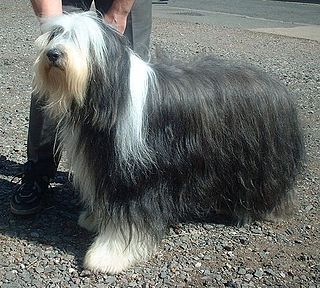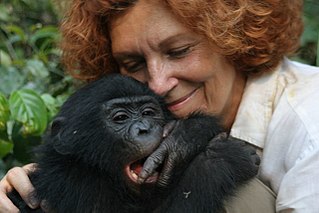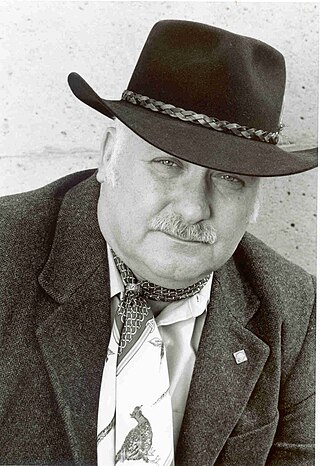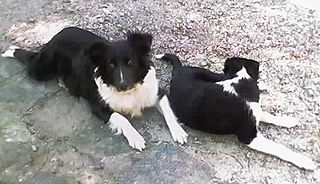This most links are dead needs additional citations for verification .(January 2021) |
Betsy (born 2002) is a black and white longhaired Border Collie, credited with being one of the world's most intelligent dogs.
This most links are dead needs additional citations for verification .(January 2021) |
Betsy (born 2002) is a black and white longhaired Border Collie, credited with being one of the world's most intelligent dogs.
Betsy lives in Vienna, Austria with her owner, who goes by the pseudonym "Schäfer" (English: Shepherd). Betsy is also a pseudonym given to her by animal cognition researchers. [1] [2] At ten weeks of age, Betsy was able to sit on command and knew numerous objects, such as a ball and set of keys, by their name and would fetch them on verbal command. [3] Betsy was discovered after her owner answered a request by National Geographic Magazine to submit intelligent animals for study. Betsy was one of two dogs (both of which were Border Collies) whose intelligence was beyond that of Rico, also a Border Collie, who knows over 200 words. [4] Betsy was featured on the cover of the March 2008 edition of National Geographic. [5]
Betsy has a vocabulary of more than 340 words, [3] [6] which rivals that of the great apes in terms of intelligence and lateral thinking. After hearing a word only twice, Betsy is able to decipher that the sound is a command or instruction and regards it as such. [2] Betsy is believed to learn in the same way that human toddlers do, if not faster. [1] Betsy is capable of interpreting the correlation between a two-dimensional photograph and the object it depicts, and is able to retrieve the item simply by seeing the image, despite never having seen the depicted object or the photograph before. [2] During testing, Betsy retrieved the correct item 38 out of 40 times. [7] Betsy knows 15 people by only their name. [3] It is believed that Betsy's unusual intelligence can be attributed to dogs' prolonged association with humans, evolution and her breed—the Border Collie was found to be the most intelligent breed of dog by psychology professor Stanley Coren in his 1994 book The Intelligence of Dogs . [8] Juliane Kaminski, a cognitive psychologist who tested Betsy, hypothesised that her abilities are the result of the use of the Border Collie breed as working dogs, their high motivation levels and that they historically had to pay close attention to their owners' commands when engaged in herding. [2]

The Siberian Husky is a medium-sized working sled dog breed. The breed belongs to the Spitz genetic family. It is recognizable by its thickly furred double coat, erect triangular ears, and distinctive markings, and is smaller than the similar-looking Alaskan Malamute.

The Border Collie is a British breed of herding dog of the collie type of medium size. It originates in the region of the Anglo-Scottish border, and descends from the traditional sheepdogs once found all over the British Isles. It is kept mostly as a working sheep-herding dog or as a companion animal. It competes with success in sheepdog trials. It has been claimed that it is the most intelligent breed of dog.

The Shetland Sheepdog, also known as the Sheltie, is a breed of herding dog that originated in the Shetland Islands of Scotland. It was formally recognized by The Kennel Club in 1909. It was originally called the Shetland Collie, but this caused controversy amongst Rough Collie breeders of the time, so the name was changed. It is a small dog, clever, vocal, willing to please, and trustworthy.

The Australian Cattle Dog, or simply Cattle Dog, is a breed of herding dog developed in Australia for droving cattle over long distances across rough terrain. This breed is a medium-sized, short-coated dog that occurs in two main colour forms. It has either red or black hair distributed fairly evenly through a white coat, which gives the appearance of a "red" or "blue" dog.

A labradoodle is a crossbreed dog created by crossing a Labrador Retriever and a Standard or Miniature Poodle. Labradoodles were intended to be a good choice for people with canine dander allergies.

A herding dog, also known as a stock dog or working dog, is a type of dog that either has been trained in herding or belongs to breeds that are developed for herding. A dog specifically trained to herd sheep is known as a sheep dog or shepherd dog.

Collies form a distinctive type of herding dogs, including many related landraces and standardized breeds. The type originated in Scotland and Northern England. Collies are medium-sized, fairly lightly-built dogs, with pointed snouts. Many types have a distinctive white color over the shoulders. Collies are very active and agile, and most types of collies have a very strong herding instinct. Collie breeds have spread through many parts of the world, and have diversified into many varieties, sometimes mixed with other dog types.

The Smooth Collie is a breed of dog developed originally for herding. It is a short-coated version of the Rough Collie of Lassie fame. Some breed organisations consider the smooth-coat and rough-coat dogs to be variations of the same breed.

The Bearded Collie, or Beardie, is a herding breed of dog once used primarily by Scottish shepherds, but now mostly a popular family companion.
Rico was a border collie dog who made the news after being studied by animal psychologists Juliane Kaminski and colleagues from the Max Planck Institute for Evolutionary Anthropology in Leipzig after his owners reported that he understood more than 200 simple words. Kaminski et al. wrote in Science that these claims were justified: Rico retrieved an average of 37 out of 40 items correctly. Rico could also remember items' names for four weeks after his last exposure.
Dog intelligence or dog cognition is the process in dogs of acquiring information and conceptual skills, and storing them in memory, retrieving, combining and comparing them, and using them in new situations.

The Lhasa Apso is a non-sporting dog breed originating in Tibet. Traditionally the breed has been used as an interior watchdog or, in other words, a sentinel.

Human–animal communication is the communication observed between humans and other animals, ranging from non-verbal cues and vocalizations to the use of language.

The dog is a domesticated descendant of the wolf. Also called the domestic dog, it is derived from extinct gray wolves, and the gray wolf is the dog's closest living relative. The dog was the first species to be domesticated by humans. Hunter-gatherers did this over 15,000 years ago in Oberkassel, Bonn, which was before the development of agriculture. Due to their long association with humans, dogs have expanded to a large number of domestic individuals and gained the ability to thrive on a starch-rich diet that would be inadequate for other canids.

Stanley Coren is a psychology professor, neuropsychological researcher and writer on the intelligence, mental abilities and history of dogs. He works in research and instructs in psychology at the University of British Columbia in Vancouver, British Columbia. He writes for Psychology Today in the feature series Canine Corner.

Dog behavior is the internally coordinated responses of individuals or groups of domestic dogs to internal and external stimuli. It has been shaped by millennia of contact with humans and their lifestyles. As a result of this physical and social evolution, dogs have acquired the ability to understand and communicate with humans. Behavioral scientists have uncovered a wide range of social-cognitive abilities in domestic dogs.

Chaser was a Border Collie with the largest tested memory of any non-human animal. Chaser worked with Professor John W. Pilley, at his home in Spartanburg, South Carolina, from eight weeks old, until Pilley's death in June 2018. Pilley spent that time training her in a formal research project. Chaser could identify and retrieve 1,022 toys by name.
The Intelligence of Dogs is a 1994 book on dog intelligence by Stanley Coren, a professor of canine psychology at the University of British Columbia. The book explains Coren's theories about the differences in intelligence between various breeds of dogs. Coren published a second edition in 2006.

The New Zealand Heading Dog is a working and herding dog that uses its visual prowess, intelligence and quick movement to control sheep. Bred from Border Collies, Heading Dogs are a sturdy, long-legged and even-haired breed. They are generally black and white in color, but may also be tan.

The Gaucho Sheepdog (Portuguese: Ovelheiro gaúcho) is a dog breed that originated in the Pampas, Brazil. The breed is not recognized by the Fédération Cynologique Internationale (FCI), but it has been recognized by the CBKC, a Brazilian kennel club affiliated with FCI. Dogs of this breed are often characterized as sturdy and agile, which makes them suitable for herding activities. The Gaucho sheepdog is widely used for herding sheep and other livestock, especially in the southern region of Brazil.
... she gets her due being on the cover of the magazine up there with all the other famous animals who have embraced that cover ...